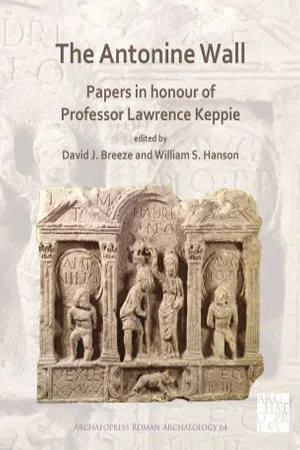
The Antonine Wall : Papers in Honour of Professor Lawrence Keppie
- English
- PDF
- Available on iOS & Android
The Antonine Wall : Papers in Honour of Professor Lawrence Keppie
About this book
The Antonine Wall, the Roman frontier in Scotland, was the most northerly frontier of the Roman Empire for a generation from AD 142. It is a World Heritage Site and Scotland's largest ancient monument. Today, it cuts across the densely populated central belt between Forth and Clyde. In this volume, nearly 40 archaeologists, historians and heritage managers present their researches on the Antonine Wall in recognition of the work of Lawrence Keppie, formerly Professor of Roman History and Archaeology at the Hunterian Museum, Glasgow University, who spent much of his academic career recording and studying the Wall. The 32 papers cover a wide variety of aspects, embracing the environmental and prehistoric background to the Wall, its structure, planning and construction, military deployment on its line, associated artefacts and inscriptions, the logistics of its supply, as well as new insights into the study of its history. Due attention is paid to the people of the Wall, not just the officers and soldiers, but their womenfolk and children. Important aspects of the book are new developments in the recording, interpretation and presentation of the Antonine Wall to today's visitors. Considerable use is also made of modern scientific techniques, from pollen, soil and spectrographic analysis to geophysical survey and airborne laser scanning. In short, the papers embody present-day cutting edge research on, and summarise the most up-to-date understanding of, Rome's shortest-lived frontier. The editors, Professors Bill Hanson and David Breeze, who themselves contribute several papers to the volume, have both excavated sites on, and written books about, the Antonine Wall.
Frequently asked questions
- Essential is ideal for learners and professionals who enjoy exploring a wide range of subjects. Access the Essential Library with 800,000+ trusted titles and best-sellers across business, personal growth, and the humanities. Includes unlimited reading time and Standard Read Aloud voice.
- Complete: Perfect for advanced learners and researchers needing full, unrestricted access. Unlock 1.4M+ books across hundreds of subjects, including academic and specialized titles. The Complete Plan also includes advanced features like Premium Read Aloud and Research Assistant.
Please note we cannot support devices running on iOS 13 and Android 7 or earlier. Learn more about using the app.
Information
Table of contents
- Cover
- Title Page
- Copyright Page
- Lawrence at Westerwood
- Dedication
- Contents Page
- List of Figures
- List of Tables
- List of Contributors
- Abbreviations
- 1. Lawrence Keppie: an appreciation
- 2. The Antonine Wall: the current state of knowledge
- 3. The Landscape at the time of construction of the Antonine Wall
- 4. The impact of the Antonine Wall on Iron Age society
- 5. Pre-Antonine coins from the Antonine Wall
- 6. Planning the Antonine Wall: an archaeometric reassessment of installation spacing
- 7. The curious incident of the structure at Bar Hill and its implications
- 8. Monuments on the margins of Empire: the Antonine Wall sculptures
- 9. Building an image: soldiers’ labour and the Antonine Wall Distance Slabs
- 10. New perspectives on the structure of the Antonine Wall
- 11. Wing-walls and waterworks. On the planning and purpose of the Antonine Wall
- 12. The importance of fieldwalking: the discovery of three fortlets on the Antonine Wall
- 13. The Roman temporary camp and fortlet at Summerston, Strathclyde
- 14. Thinking small: fortlet evolution on the Upper German Limes, Hadrian’s Wall, the Antonine Wall and Raetian Limes
- 14. Thinking small: fortlet evolution
- 15. The Roman fort and fortlet at Castlehill on the Antonine Wall:
- the geophysical, LiDAR and early map evidence
- 16. ‘... one of the most remarkable traces of Roman art ...
- in the vicinity of the Antonine Wall.’ A forgotten funerary urn of Egyptian travertine from Camelon, and related stone vessels from Castlecary
- 17. The Kirkintilloch hoard revisited
- 18. The external supply of pottery and cereals to Antonine Scotland
- 19. The army of the Antonine Wall: its strength and implications
- 20. Why was the Antonine Wall made of turf rather than stone?
- 21. Antoninus Pius’ Guard Prefect Marcus Gavius Maximus
- with an Appendix on new evidence for the Fasti of Britain under Antoninus
- 22. Civil settlement and extra-mural activity on the Antonine Wall
- 23. Roman women in Lowland Scotland
- 24. Where did all the veterans go? Veterans on the Antonine Wall
- 25. ‘So the great Romans with unwearied care’: Sir John Clerk’s museum
- 26. John Anderson and the Antonine Wall
- 27. Reconstructing Roman lives
- 28. The power of vivid images in Antonine Wall reconstructions:
- re-examining the archaeological evidence
- 29. The Antonine Wall: some challenges of mapping a complex linear monument
- 30. Connecting museums and sites Advanced Limes Applications – a Creative Europe project
- 31. The Antonine Wall as a World Heritage Site: People, priorities and playparks
- 32. ‘Then ’twas the Roman, now ’tis I’
- Back cover